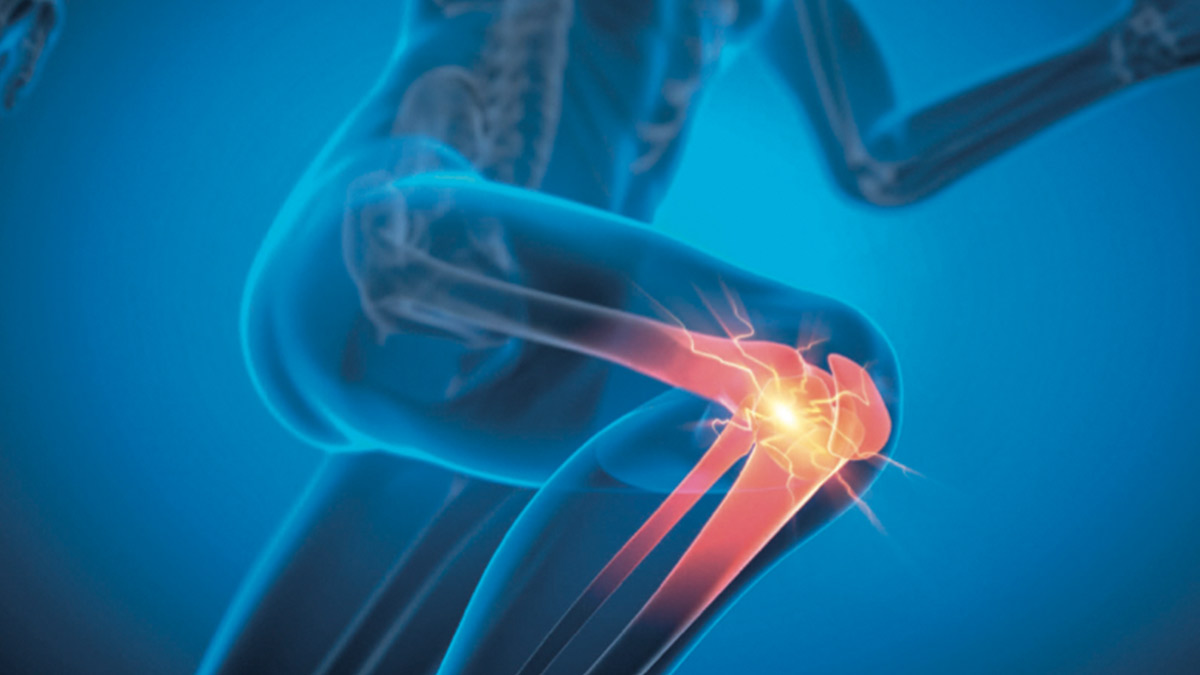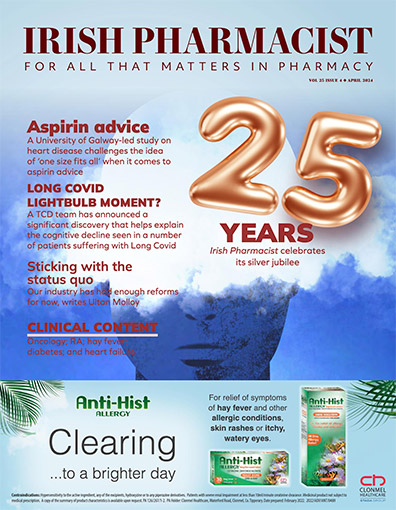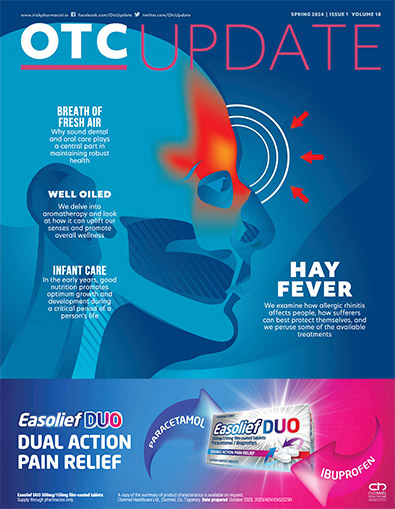A CLINICAL OVERVIEW OF DIABETES, ONE OF THE FASTEST-GROWING DISEASES IN IRELAND.
DIABETES
IN THE SPOTLIGHT
The Diabetic Federation of Ireland estimates there are over 200,000 diabetics in Ireland and that over half of these have no idea they have diabetes. Some countries have a population prevalence of up to 6 per cent for diabetes.1
WHAT IS DIABETES?
The World Health Organisation (WHO) defines diabetes mellitus as “a metabolic disorder of multiple aetiology, characterised by chronic hyperglycaemia, with disturbances of carbohydrates, fat and protein metabolism resulting from defects in insulin secretion, insulin action, or both”.2 Diabetes mellitus is a condition that occurs when the body cannot use glucose normally. Glucose is the main source of energy for the body’s cells. The levels of glucose in the blood are controlled by the hormone insulin, which is made by the pancreas. Insulin helps glucose enter the cells.
TYPES
There are two types of diabetes: Type 1, and Type 2. In Type 1 diabetes, the pancreas does not make enough insulin. In Type 2 diabetes, the body can’t respond normally to the insulin that is made, which is often called insulin resistance.
TYPE 1
This type of diabetes usually appears before the age of 40 and most often starts as a teenager. Type 1 diabetes is the least common of the two main types and accounts for between 5 and 15 per cent of all people with diabetes. You cannot prevent Type 1 diabetes.
TYPE 2
In most cases, this is linked with obesity. Obesity results in insulin resistance, which interferes with insulin’s action on glucose uptake and its affect on fatty acids and protein metabolism.3 This type of diabetes usually appears in people over the age of 40, though in South Asian and African-Caribbean people, it often appears after the age of 25. Recently, more children are being diagnosed with the condition, some as young as seven. Type 2 diabetes accounts for between 85 and 95 per cent of all people with diabetes.
DIABETES SYMPTOMS
- Frequent urination.
- Excessive thirst.
- Extreme hunger.
- Increased fatigue.
- Irritability.
- Increased weight loss.
- Blurred vision.
- Genital itching or regular thrush.
- Slow healing of wounds.
Type 1 diabetes symptoms develop very quickly, usually over a few weeks. In people with Type 2 diabetes, the signs and symptoms will not be so obvious or may even be non-existent. If you’re older, you may put the symptoms down to the ageing process, thus preventing diagnosis.
CAUSES AND RISK FACTORS
TYPE 1 DIABETES
Type 1 diabetes develops when the insulin-producing cells in the pancreas have been destroyed. It is not known for sure why these cells have been damaged, but the most likely cause is an abnormal reaction of the body to the cells. This may be triggered by a viral or other infection.
TYPE 2 DIABETES
Risk factors are as follows:
- Age: Risk of diabetes increases in patients aged over 40, or over 25 in African and Asian patients.
- Family and ethnicity: Having diabetes in the family increases the risk of diabetes. The closer the relative is, the greater the risk. People of Afro-Caribbean or South Asian origin are at least five times more likely to develop diabetes.
- Weight: Over 80 per cent of people diagnosed with Type 2 diabetes are overweight. The more overweight and inactive the person is, the greater is their risk of diabetes.
- Waist size: Women — if the waist measures 31.5in (80cm) or more, the risk of diabetes increases.
Men — if the waist is 37in (94cm) or more, this means there is increased risk of developing diabetes.
GESTATIONAL DIABETES
Pregnant women can develop a temporary type of diabetes called gestational diabetes. Having this, or giving birth to a large baby, can increase the risk of a woman going on to develop diabetes in the future.
DIABETES TREATMENT
The aim of diabetes treatment is to do what the body once did automatically which is to mimic the insulin pattern before diabetes and to keep blood sugar under control.
For Type 1 diabetes, insulin is always part of treatment, as the body does not produce any insulin. In Type 2 diabetes, the body still produces some insulin, so non-drug options or drugs may be used to help the body make better use of the insulin that it still produces.
TREATMENT OF TYPE 1 DIABETES
There is no cure for type 1 diabetes, but it can be kept under control. Type 1 diabetes is controlled by administering insulin. This allows glucose to be absorbed into cells and converted into energy, stopping it building up in the blood.
TREATMENT OF TYPE 2 DIABETES
Many with Type 2 diabetes can manage to control their condition simply by changing their lifestyle. Changes include:
(I have discussed non-pharmacological treatment options in Irish Pharmacist magazine in the past, so for the purpose of this article, I will concentrate on pharmaceutical treatment options.)
PHARMACOLOGICAL TREATMENT OPTIONS
If lifestyle changes alone don’t reduce glucose levels, medication may be used to increase insulin production and strengthen its effect. All the types of oral hypoglycaemic drugs and insulin are safe in older patients, although each has some limitations in older people. ‘Start low and go slow’ is a good principle to follow when starting any new medications in an older adult.
Metformin improves the effectiveness of insulin by reducing the amount of glucose released from the liver and improving the way glucose is used by muscles. It causes less weight gain than other diabetic medication. In the UKPDS, metformin reduced diabetes associated deaths by 43 per cent over a 10-year follow-up.4 Metformin acts on the liver to lower production of glucose and reduce glycogenolysis; it has no effect on insulin release, so is not associated with hypoglycaemia. Up to 3g of metformin can be administered daily.14 A 2005 Cochrane Review concluded that no other anti-diabetic drug showed more benefit in terms of glycaemia control, body weight or lipids than metformin in Type 2 diabetes.15 Gastrointestinal (GI) upset is the most common side-effect and has been reported in up to 50 per cent of patients.16
Metformin is an attractive agent to use in the elderly due to a low risk of hypoglycaemia. However, it should be given with caution in older diabetic patients because of the risk of lactic acidosis. Older patients often have impaired renal function, despite an apparently normal serum creatinine concentration. Weight loss and gastrointestinal side-effects may also be limiting factors in older adults taking metformin. Therefore, metformin should be used with caution in older patients.
Sulphonylureas encourage the pancreas to produce more insulin. Because they stimulate insulin secretion, they are most effective in newly- or recently-diagnosed patients who still have relatively active beta-cell function. In the UKPDS, sulphonylureas reduce diabetic-related deaths by 36 per cent.4 Sulphonylurea monotherapy is effective in 75-to-80 per cent of patients with type 2 diabetes; however, treatment ‘failure’ occurs at a rate of 5-to-10 per cent of patients per annum.17 Sulfonylureas are usually well tolerated in older patients; however, hypoglycaemia is the most common side-effect and is more common with older, long-acting sulfonylurea drugs. However, Gliclazide MR is well tolerated in elderly patients.
Thiazolidinediones reduce the body’s resistance to insulin and are generally limited to use with metformin and sulphonylureas if other standard treatments were not working or not tolerated. They are licensed as monotherapy in obese patients if metformin is ineffective or not tolerated. They work by reducing insulin resistance in adipose tissue, muscle, and liver.17 They take up to 12 weeks to exert their full affect. Thiazolidinediones are useful for some older diabetic patients because they can be given to patients who have impaired renal function. They are well tolerated in older adults and do not cause hypoglycaemia. However, limited experience, high cost, and concerns regarding fluid retention, congestive heart failure, MI, and fractures limit their usefulness. Weight gain is a side-effect, so they should be avoided in obese patients.
Rosiglitazone (Avandia) was withdrawn from the European market in October 2010 because new research showed it increased the risk of cardiovascular problems, including increasing the risk of MI and heart failure. It was considered that its benefits no longer outweighed its risks. Pioglitasone (Actos) is still on the Irish market, but must be used in caution in those with cardiovascular problems.
Newer medicines called DPP-4 inhibitors, such as sitagliptin (Januvia), help the body to produce more insulin in response to meals.
They work by enhancing the levels of active incretin hormones, thus enhancing insulin and reducing glucagon secretions.18 DPP-4 inhibitors don’t cause weight gain and only rarely cause hypos.
The combination of sitagliptin and metformin has been shown to be better tolerated (14.5 per cent incidence of adverse effects) compared with a combination of sulfonylurea and metformin (30.3 per cent incidence of adverse effects). Long-term safety with this class of drug in the elderly has not been established.
Acarbose (Glucobay) lowers blood glucose by slowing the breakdown of some carbohydrates. Acarbose reduces the digestion and absorption of starch and sucrose by competitively inhibiting the intestinal enzymes involved in the degradation of disaccharides, oligosaccharides, and polysaccharides. The reduction in HbA1c is modest; however, it very unlikely to cause weight gain.19 The main side-effects which affect over 10 per cent of patients and limits its use are flatulence and diarrhoea.20 The gastrointestinal side-effects are due to intra-colonic fermentation of the unabsorbed sugars and reduce with time. Acarbose has not been widely tested in elderly diabetic patients, but is likely to be safe and effective.
Meglitinides include repaglinide (Novonorm) and nateglinide (Starlix). Meglitinides act as postprandial glucose regulators. They increase insulin secretion by binding to specific sites within the ß cells in the pancreas. They have a rapid onset of action, meaning they need to be administered shortly (one-to-30 minutes) before meals.21 They have a short duration of action, requiring multiple daily dosing.22 Long-term data on treatment outcomes of meglitinides are not available.23 Meglitinides may play a useful role in patients with irregular meal times (ie, shift workers).23 Gastrointestinal upset is generally less than with metformin; however, weight gain is greater than experienced with metformin and can be as much as 3kg in three months. Because they are metabolised by the cytochrome P450, their potential for interactions is greater than other oral anti-diabetics. Their use is limited for many factors, including their inconvenient dosage regimen, ie, they must be taken immediately before meals and need multiple daily dosage. Other oral anti-diabetics have more convenient dosage regimens.
Glucagon-like peptide-1 receptor agonists (GLP-1 Ras) are synthetic peptide drugs that work by increasing the secretion of insulin and reducing secretion of glucagon in response to hyperglycaemia.24
GLP-1 RAs are very effective at lowering blood sugar levels and work in three main ways to to manage blood sugar:
- Slow stomach-emptying. Slowing digestion down means nutrients in food are released more slowly, thus preventing blood sugar from spiking after a meal.
- Increase insulin production. GLP-1 RAs help the body make more insulin. This insulin is released after a meal when your blood sugar level rises.
- Reduce sugar released from the liver. The liver releases extra sugar into the blood as needed. GLP-1 RAs prevent the liver from putting out too much sugar.
Liraglutide, semaglutide and dulaglutide have also shown benefits for heart health and kidney function.
They are administered by subcutaneous injection, twice-daily in the case of exenatide (Bydureon and Byetta), once-daily in the case of liraglutide (Victoza), and once-weekly in the case of the longer action versions semaglutide (Ozempic) and dulaglutide (Trulicity). GI upset (including nausea, vomiting and diarrhoea) is the most common side-effect of GLP-1 Ras and was recorded in up to 50 per cent of patients in clinical trials.25 Hypoglycaemia occurred in over 10 per cent of patients when combined with a sulfonylurea in clinical trials of exenatide, so the dose of the sulfonylurea should be reduced if combined with exenatide. Hypoglycaemia is also a risk when GLP-1 RAs are used in combination with insulin.
Meglitinides may play a useful role in patients with irregular meal times
The first oral GLP-1 RA is called semaglutide (Rybelsus) was first launched in Europe in April 2020. It is not yet reimbursable by the HSE under the LTI and GMS schemes, so in practise, it is not used in Ireland yet. The National Centre for Pharmacoeconomics (NCPE) decides on what medicines can be reimbursed by the HSE based on effectiveness versus cost. The NCPE currently recommends that oral semaglutide should not be considered for reimbursement unless cost-effectiveness can be improved relative to existing therapy (last reviewed Feb 2021).
Fast-acting insulin preparations include insulin aspart (NovoRapid) and insulin lispro (Humalog). The onset of action of insulin aspart is 10-to-20 minutes and the duration of action is three-to-five hours. Insulin lispro has an onset of action of approximately 15 minutes and duration of action of two-to-five hours.26
Insulin aspart is injected subcutaneously immediately before meals or, when necessary, soon after. Insulin lispro is injected subcutaneously shortly before meals or, when necessary, soon after. Insulin aspart and insulin lispro are normally used in combination with longer-acting insulin to provide a steady glucose level throughout the day. The dose of insulin aspart or lispro needs to be individualised to the patient. The fast-acting insulins may also be used for continuous subcutaneous infusion using an insulin infusion pump. Biphasic preparations are also available (ie, NovoMix 30, Humalog Mix25). These contain fast-acting (aspart or lispro) and intermediate-acting insulin analogues.26
The long-acting insulin glargine (Lantus) is administered subcutaneously once-daily. It can be administered at any time, but it should be given at the same time each day. The dosage and timing of administration should be individualised to the patient. It shows a constant concentration-effect versus time profile, which lasts for approximately 24 hours. Insulin glargine is used as an additional therapy to oral hypoglycaemic agents in type 2 diabetes where oral hypoglycaemic agents do not provide adequate glucose control on their own.27 Insulin glargine was also associated with similar or less weight gain compared with isophane insulin (intermediate action).26 Patients with both type 1 and 2 diabetes experienced greater diabetic control with insulin glargine compared with isophane insulin.26
Interactions with other drugs must be considered when determining dose of insulin. Drugs which reduce hypoglycaemic activity and may increase insulin requirement include oral contraceptives, thiazides, glucocorticoids, thyroid hormones, sympathomimetics and danazol. Substances that enhance hypoglycaemic activity and may decrease insulin requirements include oral anti-diabetics, certain antidepressants (MAOIs and SSRIs), non-cardio selective beta blockers, certain ACE inhibitors (captopril, enalapril), angiotension 2 inhibitors, aspirin, alcohol, anabolic steroids, and sulphonamides. Beta blockers also mask the symptoms of hypoglycaemia and alcohol may intensify and prolong the hypoglycaemic effect of insulin.
Insulin is sometimes under-utilised in the elderly because of fear (by the doctor, patient, or family) that it is too complicated or dangerous. With the availability of long-acting insulins, ie, Lantus, Levemir, it has become easier to add once-daily insulin to oral hypoglycemic medications in older patients who have poor glycaemic control. The quality of life of many older patients improves substantially when they take one or two daily doses of intermediate- or long-acting insulin.
WHICH DRUG TO CHOOSE?
Metformin remains the most effective monotherapy, especially in obese patients. Sulfonylureas remain a good choice if the patient is not overweight. Repaglinide and acarbose are also authorised for monotherapy, but are rarely used due to reasons described above. Thiazolidinediones may be used as monotherapy only in overweight patients if metformin is ineffective or not tolerated, but should be avoided in patients with cardiovascular problems.
Step 2 if monotherapy is ineffective is dual therapy, which includes metformin and/ or sulfonylurea and/or thiazolidinedione. Sitagliptin (Januvia) is a popular add-on therapy to metformin due to its success and low incidence of side-effects. Meglitinides, acarbose and exenatide are also authorised for combination therapy.
Step 3 is triple therapy (metformin and/or sulfonylurea and/or thiazolidinedione and/ or meglitinides and/or acarbose). Insulin or GLP-1 RAs may be considered with dual therapy but should be initiated by a specialist.
It must be borne in mind that metformin and sulphonureas provide a greater reduction in HbA1c than any of the newer oral anti-diabetic drugs. Metformin and sulphonureas reduce HbA1c by greater than 1.5 per cent; no other oral anti-diabetic drug reduces HbA1c by greater than 1.5 per cent.19,23,27 Metformin and sulphonureas are central to any treatment regimen of type 2 diabetes. Metformin and sulphonureas are also less expensive than other oral anti-diabetic drugs.
HYPERTENSIVE CONTROL FOR DIABETICS
The co-existence of hypertension and diabetes mellitus (either Type 1/2) substantially increases the risk of complications, including stroke, coronary heart disease, congestive heart failure and peripheral vascular disease, and increases cardiovascular mortality. For example, type 2 diabetics have a two-to-four-fold higher risk of developing coronary heart disease, and CVD accounts for 65-to-75 per cent of deaths in people with diabetes.29,30
The development of hypertension may be due to the onset of diabetic nephropathy in Type 1 diabetics. In both Type 1 and 2, the threshold for starting treatment is BP ?140/90mmHg. Previously, the blood pressure treatment target for diabetics was <130/80mmHg if there were signs of kidney damage. In 2019, NICE updated these recommendations, as there was no sufficient evidence to suggest that lower blood pressure targets for diabetics reduced the rate of CVD.31 Therefore, people with diabetes (with signs of kidney disease) now have the same blood pressure targets as people who do not have diabetes. Evidence supports the use of many drugs, particularly the ACE inhibitors or ARBs. Maintaining normal BP with the use of ACE inhibitors or ARBs reduces the rate of decline in renal function. NICE advises that the first-line antihypertensive drug for type 2 diabetes should be a once-daily generic ACE inhibitor, ie, Lisinopril, Ramipril, or an ARB, ie, Losartan or Irebesartan.31
References
1. Stumvoll M, Goldstein BJ et al, Type 2 diabetes: principles of pathogenesis and therapy. Lancet 2005; 365: 1333-46.
2. World Health Organisation Expert Committee. Definition, diagnosis and classification of diabetes mellitus and its complications. Report of a WHO consultation, part 1: Diagnosis and classification of diabetes mellitus. Geneva: World Health Organisation 1999.
3. Nolan JJ. What is type 2 diabetes? Diabetes: Basic Facts. Medicine 2006; 34 (2): 52-56.
4. Stratton I, Adler A et al, Association of glycaemia with macrovascular and microvascular complications of type 2 diabetes (UKPDS 35): Prospective observational study. BMJ 2000; 321: 405-12.
5. Thomas DE, Elliott EJ, Naughton GA. Exercise for type 2 diabetes mellitus. Cochrane Database of Systematic Reviews 2006, Issue 3. Art. No: CD002968. DOI: 10.1002/14651858. CD002968. Pub2.
6. Barth JH et al. Consensus meeting on reporting glycated haemoglobin and estimated average glucose in the UK: Report to the National Director for Diabetes, Department of Health. Ann Clin Biochem 2008; 45: 343–4.
7. Fisher M. Macrovascular disease in diabetes. Complications of Diabetes. Medicine 2006; 34(3): 101-103. 2006.
8. Hunter S, Bell P. Diabetes, and hypertension. Management of Diabetes. Medicine 2006; 34 (2): 76-79.
9. Dobesh P. Managing hypertension in patients with type 2 diabetes mellitus. American Journal Health-Syst Pharm. 2006; 63: 1140-9.
10. The Task Force on Diabetes and Cardiovascular Diseases of the European Society of Cardiology (ESC) and of the European Association for the Study of Diabetes (EASD). Guidelines on diabetes, pre-diabetes, and cardiovascular diseases: Executive summary. European Heart Journal 2007; 28: 88-136.
11. NMIC (National Medicines Information Centre), St James’s Hospital Dublin. Update on Hypertension. NMIC Bulletin 2004; Volume 10:1.
12. Anti Thrombotic Trialists’ Collaboration. Collaborative meta-analysis of randomised trials of anti platelet therapy for prevention of death, myocardial infarction, and stroke in high-risk patients. BMJ 2002; 324:71-85.
13. Moore H, Summerbell C, et al. Dietary advice for treatment of type 2 diabetes mellitus in adults (Review). Cochrane Database of Systematic Reviews 2004, Issue 2. Art. No: CD004097. DOI: 10.1002/14651858. CD004097.pub3.
14. SPC Glucophage. Available at www. medicines.ie.
15. Saenz A, Fernandez-Esteban I, et al. Metformin monotherapy for type 2 diabetes mellitus (Review). Cochrane Database of Systematic Reviews 2005, Issue 3. Art. No.: CD002966. DOI: 10.1002/14651858. CD002966.pub3.
16. Cuthbertson D, Leese G. Managing type 2 diabetes: Oral anti-diabetic drugs. Prescriber 5 July 2003: 47-52.
17. Davies M, Srinivasan B. Glycaemic Management of type 2 diabetes. Medicine 2006; 34 (2): 69-75.
18. Sitagliptin in type 2 diabetes. ‘On the Horizon’ – Post Launch Update. National Prescribing Centre and Wessex Drug and Medicines Information Centre. May 2007. Monograph Number: 1.
19. Heine RJ, Diamant M, et al. Management of hyperglycaemia in type 2 diabetes. BMJ 2006; 333: 1200-4.
20. SPC Glucobay. Available at www.medicines.ie.
21. SPC Starlix. Available at www.medicines.ie.
22. Black C, Donnelly P, et al. Meglitinide analogues for type 2 diabetes mellitus (Review). Cochrane Database of Systematic Reviews 2007, Issue 2. Art. No: CD004654. DOI: 10.1002/14651858. CD004654. pub2.
23. Type 2 diabetes (part 1): The management of blood glucose. MeReC Briefing, National Prescribing Centre, NHS, 2004; Issue No. 25.
24. Cvetkovic R, Plosker G. Exenatide. A Review of Its use in Patients with Type 2 Diabetes Mellitus (as an Adjunct to Metformin and/or a Sulfonylurea). Drugs 2007; 67 (6): 935-954.
25. SPC Byetta. Available at www.medicines.ie.
26. NMIC (National Medicines Information Centre), St James’s Hospital, Dublin. Diabetes Mellitus – Recent therapeutic developments. Volume 9. Number 4. 2003.
27. Nathan DM, Buse JB, et al. Management of hyperglycaemia in type 2 diabetes: A consensus algorithm for the initiation and adjustment of therapy. Diabetologia 2006; 49: 1711-1721.
28. Irish National Centre of Pharmacoeconomics (NCPE). HTA ID: 20011. Review of cost effectiveness of Semaglutide (Rybelsus). Last reviewed Feb 2021.
29. Moss SE, Klein R, Klein BE. Cause-specific mortality in a population-based study of diabetes. Am J Public Health. 1991; 81:1158–62.
30.Geiss LS, Herman WM, Smith PJ. Diabetes in America. 2nd ed. Bethesda, MD: NIH & NIDDK: National Diabetes Information Clearing house; 1995. Mortality in non-insulin-dependent diabetes; pp. 233–55. In: National Diabetes Data Group, editor.
31. Hypertension in adults: Diagnosis and management. NICE guideline [NG136]. Published date: 28 August 2019.
CONTRIBUTOR INFORMATION

Written and researched by Eamonn Brady (MPSI), owner of Whelehans Pharmacies in Mullingar Tel 04493 34591 (Pearse St) or 04493 10266 (Clonmore). www.whelehans. inet. Eamonn specialises in the supply of medicines and training needs of nursing homes throughout Ireland. Email ebrady@whelehans.ie







